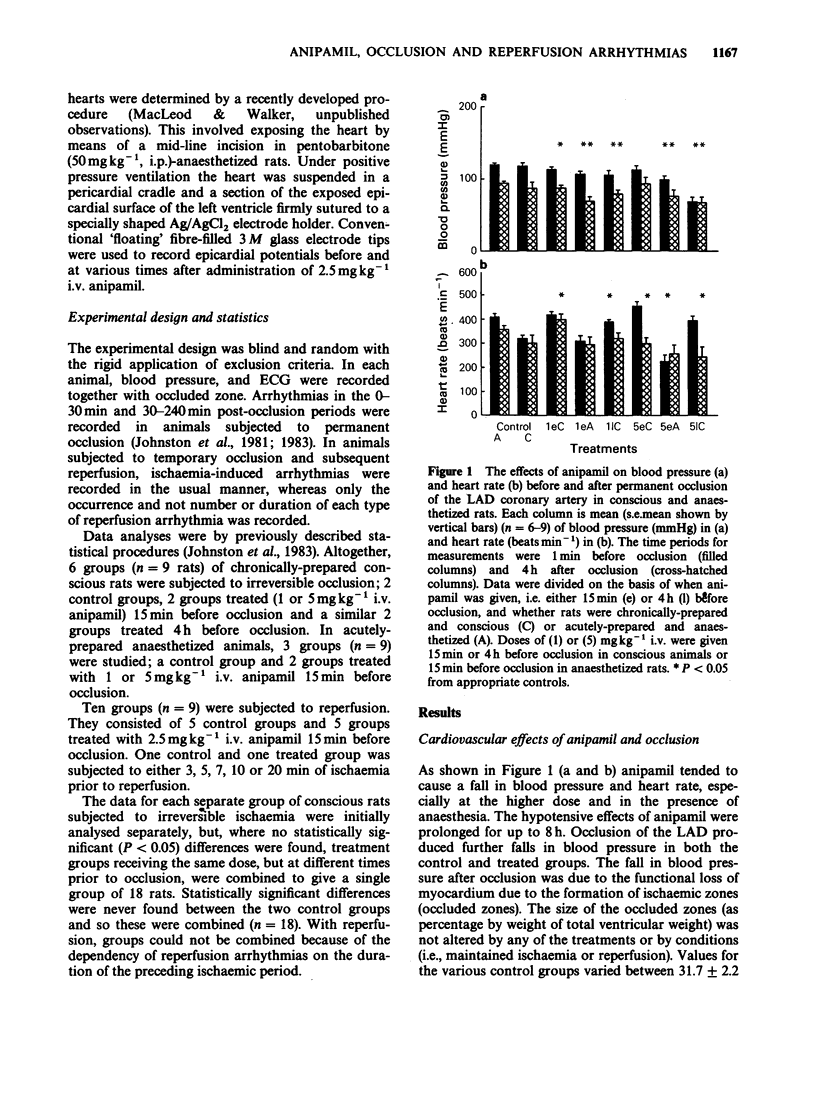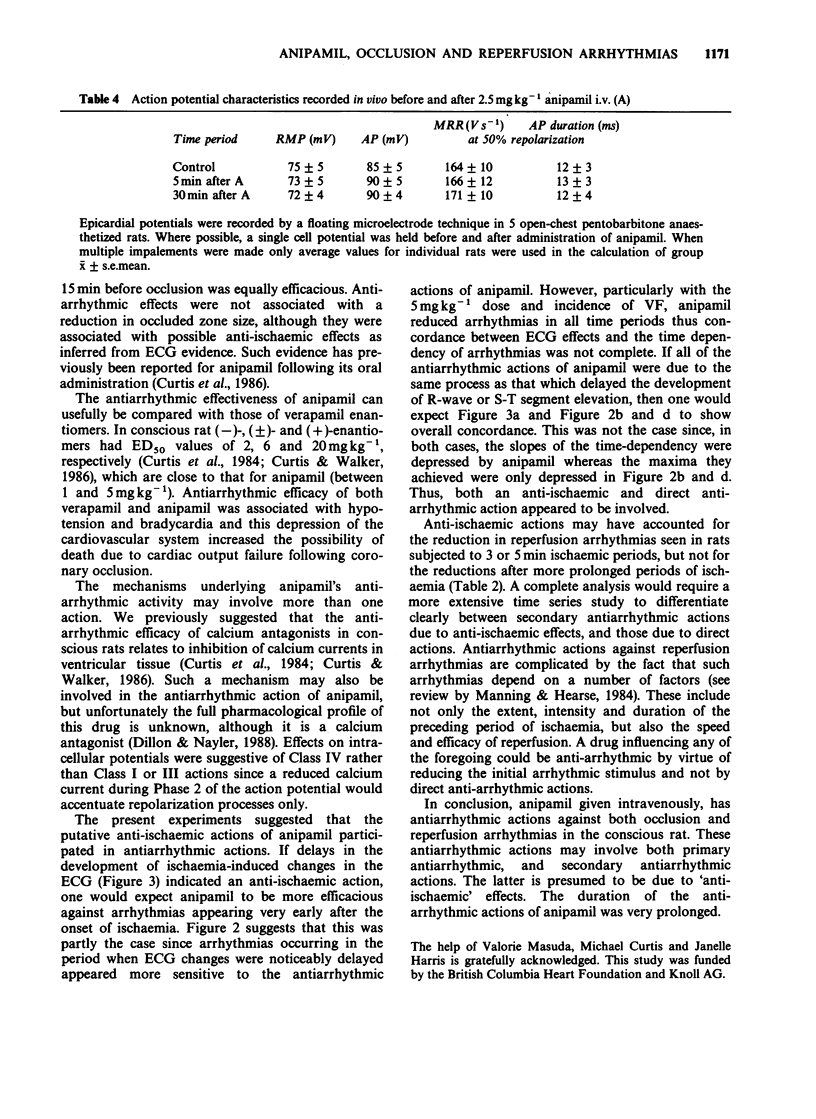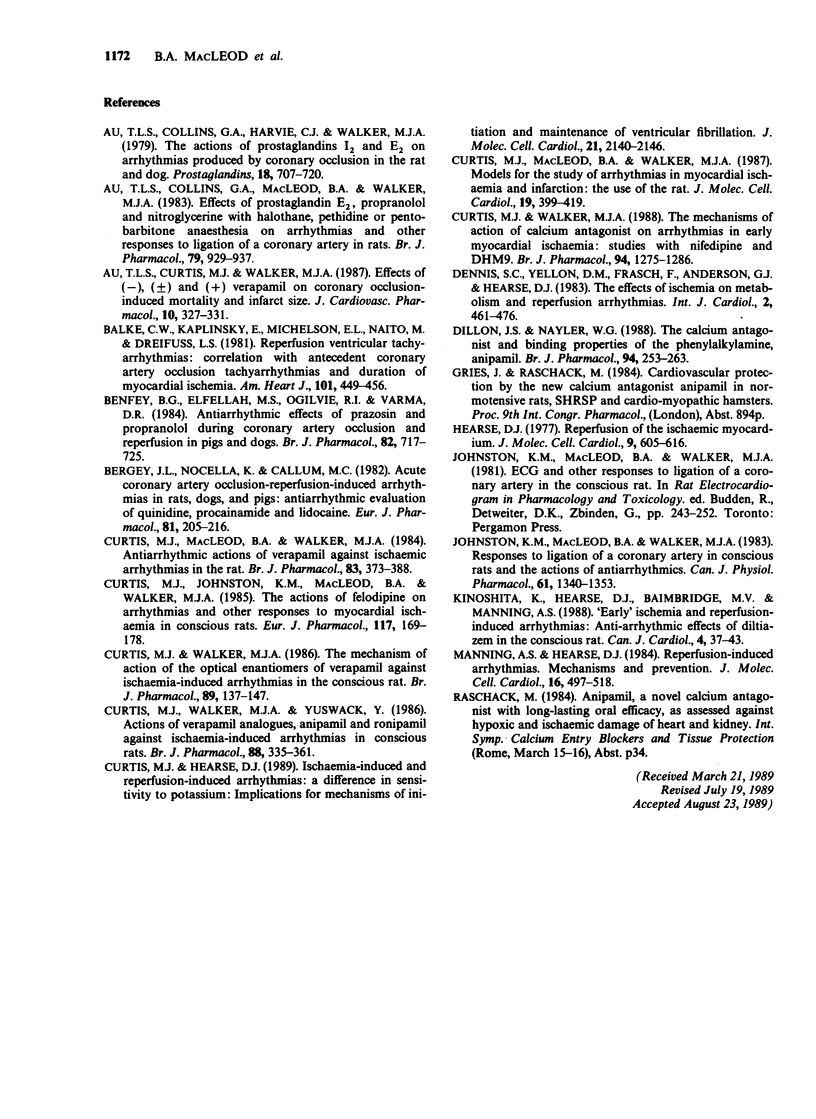Abstract
1. Anipamil, a long acting analogue of verapamil, was tested for its actions against arrhythmias induced by ischaemia and reperfusion in conscious and anaesthetized rats, as well as for effects on epicardial intracellular action potentials. 2. When given 15 min or 4 h before coronary occlusion, 1 and 5 mg kg-1 anipamil reduced ischaemia-induced arrhythmias in conscious rats. The same doses also reduced arrhythmias when given 15 min before occlusion in acutely-prepared anaesthetized rats. ED50 values were between 1 and 5 mg kg-1. 3. The incidence of reperfusion arrhythmias depended upon the period of regional ischaemia prior to reperfusion such that the peak incidence occurred after 5-7 min of ischaemia. Anipamil (2.5 mg kg-1, i.v.) selectively abolished the reperfusion arrhythmias induced by short periods of ischaemia, although some antiarrhythmic effects were seen for all periods of ischaemia. 4. Anipamil slowed the rate of development of R-wave increases and S-T segment elevations induced by ischaemia, but did not reduce the maximum values they attained. 5. Anipamil (2.5 mg kg-1 i.v.) lacked Class I or III electrophysiological actions on intracellular action potentials recorded in vivo from the epicardium of rat hearts. 6. In conclusion, the antiarrhythmic actions of anipamil appeared to depend upon calcium antagonism which may have reduced arrhythmias by a combination of anti-ischaemic and direct anti-arrhythmic actions. Presumed anti-ischaemic actions changed the relationship between the duration of preceding ischaemia and resulting reperfusion arrhythmias.
Full text
PDF







Selected References
These references are in PubMed. This may not be the complete list of references from this article.
- Au T. L., Collins G. A., Harvie C. J., Walker M. J. The actions of prostaglandins I2 and E2 on arrhythmias produced by coronary occlusion in the rat and dog. Prostaglandins. 1979 Nov;18(5):707–720. doi: 10.1016/0090-6980(79)90091-1. [DOI] [PubMed] [Google Scholar]
- Au T. L., Collins G. A., Macleod B. A., Walker M. J. Effects of prostaglandin E2, propranolol and nitroglycerine with halothane, pethidine or pentobarbitone anaesthesia on arrhythmias and other responses to ligation of a coronary artery in rats. Br J Pharmacol. 1983 Aug;79(4):929–937. doi: 10.1111/j.1476-5381.1983.tb10538.x. [DOI] [PMC free article] [PubMed] [Google Scholar]
- Au T. L., Curtis M. J., Walker M. J. Effects of (-), (+/- ), and (+) verapamil on coronary occlusion-induced mortality and infarct size. J Cardiovasc Pharmacol. 1987 Sep;10(3):327–331. doi: 10.1097/00005344-198709000-00012. [DOI] [PubMed] [Google Scholar]
- Balke C. W., Kaplinsky E., Michelson E. L., Naito M., Dreifus L. S. Reperfusion ventricular tachyarrhythmias: correlation with antecedent coronary artery occlusion tachyarrhythmias and duration of myocardial ischemia. Am Heart J. 1981 Apr;101(4):449–456. doi: 10.1016/0002-8703(81)90135-6. [DOI] [PubMed] [Google Scholar]
- Benfey B. G., Elfellah M. S., Ogilvie R. I., Varma D. R. Anti-arrhythmic effects of prazosin and propranolol during coronary artery occlusion and re-perfusion in dogs and pigs. Br J Pharmacol. 1984 Jul;82(3):717–725. doi: 10.1111/j.1476-5381.1984.tb10811.x. [DOI] [PMC free article] [PubMed] [Google Scholar]
- Bergey J. L., Nocella K., McCallum J. D. Acute coronary artery occlusion-reperfusion-induced arrhythmias in rats, dogs and pigs: antiarrhythmic evaluation of quinidine, procainamide and lidocaine. Eur J Pharmacol. 1982 Jul 9;81(2):205–216. doi: 10.1016/0014-2999(82)90438-1. [DOI] [PubMed] [Google Scholar]
- Curtis M. J., Johnston K. M., Macleod B. A., Walker M. J. The actions of felodipine on arrhythmias and other responses to myocardial ischaemia in conscious rats. Eur J Pharmacol. 1985 Nov 5;117(2):169–178. doi: 10.1016/0014-2999(85)90601-6. [DOI] [PubMed] [Google Scholar]
- Curtis M. J., MacLeod B. A., Walker M. J. Antiarrhythmic actions of verapamil against ischaemic arrhythmias in the rat. Br J Pharmacol. 1984 Oct;83(2):373–385. doi: 10.1111/j.1476-5381.1984.tb16497.x. [DOI] [PMC free article] [PubMed] [Google Scholar]
- Curtis M. J., Macleod B. A., Walker M. J. Models for the study of arrhythmias in myocardial ischaemia and infarction: the use of the rat. J Mol Cell Cardiol. 1987 Apr;19(4):399–419. doi: 10.1016/s0022-2828(87)80585-0. [DOI] [PubMed] [Google Scholar]
- Curtis M. J., Walker M. J. The mechanism of action of calcium antagonists on arrhythmias in early myocardial ischaemia: studies with nifedipine and DHM9. Br J Pharmacol. 1988 Aug;94(4):1275–1286. doi: 10.1111/j.1476-5381.1988.tb11648.x. [DOI] [PMC free article] [PubMed] [Google Scholar]
- Curtis M. J., Walker M. J. The mechanism of action of the optical enantiomers of verapamil against ischaemia-induced arrhythmias in the conscious rat. Br J Pharmacol. 1986 Sep;89(1):137–147. doi: 10.1111/j.1476-5381.1986.tb11129.x. [DOI] [PMC free article] [PubMed] [Google Scholar]
- Curtis M. J., Walker M. J., Yuswack T. Actions of the verapamil analogues, anipamil and ronipamil, against ischaemia-induced arrhythmias in conscious rats. Br J Pharmacol. 1986 Jun;88(2):355–361. doi: 10.1111/j.1476-5381.1986.tb10211.x. [DOI] [PMC free article] [PubMed] [Google Scholar]
- Dennis S. C., Yellon D. M., Frasch F., Anderson G. J., Hearse D. J. The effects of ischemia on metabolism and reperfusion arrhythmias. Int J Cardiol. 1983;2(5-6):461–478. doi: 10.1016/0167-5273(83)90147-x. [DOI] [PubMed] [Google Scholar]
- Dillon J. S., Nayler W. G. The Ca2+ -antagonist and binding properties of the phenylalkylamine, anipamil. Br J Pharmacol. 1988 May;94(1):253–263. doi: 10.1111/j.1476-5381.1988.tb11522.x. [DOI] [PMC free article] [PubMed] [Google Scholar]
- Hearse D. J. Reperfusion of the ischemic myocardium. J Mol Cell Cardiol. 1977 Aug;9(8):605–616. doi: 10.1016/s0022-2828(77)80357-x. [DOI] [PubMed] [Google Scholar]
- Johnston K. M., MacLeod B. A., Walker M. J. Responses to ligation of a coronary artery in conscious rats and the actions of antiarrhythmics. Can J Physiol Pharmacol. 1983 Nov;61(11):1340–1353. doi: 10.1139/y83-193. [DOI] [PubMed] [Google Scholar]
- Kinoshita K., Hearse D. J., Braimbridge M. V., Manning A. S. 'Early' ischemia and reperfusion-induced arrhythmias: antiarrhythmic effects of diltiazem in the conscious rat. Can J Cardiol. 1988 Jan-Feb;4(1):37–43. [PubMed] [Google Scholar]
- Manning A. S., Hearse D. J. Reperfusion-induced arrhythmias: mechanisms and prevention. J Mol Cell Cardiol. 1984 Jun;16(6):497–518. doi: 10.1016/s0022-2828(84)80638-0. [DOI] [PubMed] [Google Scholar]


